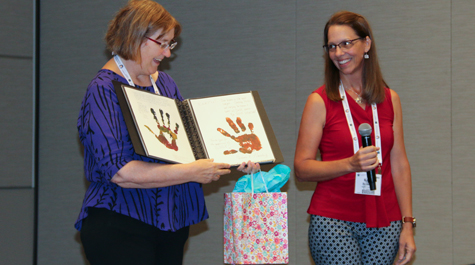Geological Society recognizes W&M’s Heather Macdonald at its annual meeting
The Geological Society of America devoted a large portion of its 2019 annual meeting to recognizing the contributions of William & Mary’s Heather Macdonald.
“Celebrating the Role of Heather Macdonald in Geoscience Education in Two-Year Colleges” occupied much of the September 23 schedule of events for its conference, held in Phoenix. Macdonald is Chancellor Professor in the William & Mary’s Department of Geology.
Cathryn A. Manduca, from the Science Education Resource Center (SERC) at Carleton College, opened the morning session, setting the tone for the day by pointing out Macdonald’s contributions to the development of programs supporting geosciences instruction at the undergraduate level.
Manduca and Macdonald were among the originators of On the Cutting Edge, an initiative that began in 2002 to bring together web sites, workshops and research ideas to support faculty teaching earth sciences at the undergraduate level. The program, based at SERC, began in 2002 and has been supported by several million dollars in funding from the National Science Foundation. Macdonald, Manduca and the other “Cutting Edge” leaders were awarded the Science Prize for Online Resources by the American Association for the Advancement of Science in 2010.
Manduca’s talk highlighted Macdonald’s contributions to Cutting Edge and other initiatives that have created a community dedicated to improving geoscience instruction at the undergraduate level and especially at two-year colleges.
“Heather has played an incredibly important role in the development of the geo2YC community, its programming and its leadership. This session demonstrated how much the geo-ed community values both this work and Heather,” Manduca wrote in an email from the GSA event. “Her caring, humor and tireless dedication was demonstrated over and over again throughout the day.”
GSA dedicated full morning and afternoon sessions, as well as an all-day poster session, to “Celebrating the Role of Heather Macdonald.” Beyond the tributes to the eponymous honoree, the presentations explored the improving state of undergraduate education in the earth sciences, with emphasis on two-year schools.
Presenters at the Macdonald-centric sessions included some William & Mary alumni who made the transition from student of Macdonald to colleague. Callan Bentley ’96 is now assistant professor of geology at Northern Virginia Community College. He spoke on “A Field Trip About Field Trips: The 2019 DC Metro Region's SAGE 2YC Field Workshop,” a professional development experience made possible by SAGE 2YC (Supporting and Advancing Geoscience Education at Two-Year Colleges). It’s an NSF-supported initiative aimed at professional development for faculty at two-year colleges. Macdonald is a principal investigator at SAGE 2YC.
Two of Macdonald’s former students who presented at GSA are now in the geology department at Thomas Nelson Community College. Peter Berquist ’01 is chair of the Thomas Nelson department, which includes Lynsey LeMay ’02, instructor of geology. LeMay said she met Macdonald on the first day of the fall semester, 1999.
“She was my instructor for physical geology,” said LeMay, who went on to get a master’s degree from William & Mary’s School of Marine Science at VIMS in 2007. “And so, my first encounter with Heather was on the very first day of class, in that fall semester. And I remember leaving that class, and calling my parents to say, ‘I’ve figured it out! I want to be a geology teacher.’”
LeMay and Berquist spoke in the morning session on “Heather Macdonald: A Positive Impact Factor Influencing Persistence and Success in the Geosciences” and then “Forging Professional Networks: Over Two Decades of Influence from Dr. Heather Macdonald,” in the afternoon session.
“I’ve seen Heather as a faculty member: she was one of my professors. And now I’ve been able to work alongside of her, so I can say that she is extremely selfless,” LeMay said in a phone interview before the GSA meeting. “She has big ideas on how the geoscience community as a whole can better itself, whether it’s addressing inclusivity issues, or how we're engaging our students in active learning, to support their learning styles. She’s also interested in building better professional development for faculty. It's all about bettering the community that she's a part of.”
The GSA session is not the first honor that Macdonald has received. In 2014, she became the recipient of the Excellence in Geophysical Education Award of the American Geophysical Union as well as the Robert Christman Award of the National Association of Geoscience Teachers.
The Geological Society of America has a membership of more than 20,000 that reaches far beyond the United States — or the Americas. There are GSA members in more than 100 countries, united in a “a common purpose to study the mysteries of our planet (and beyond) and share scientific finding.”
In addition to the sessions focusing on the contributions of Heather Macdonald, the GSA Annual Meeting included discussions revolving around the six-millionth anniversary of the Grand Canyon, new evidence regarding the age of the Sahara and findings that the ancient Incan city of Machu Picchu was intentionally built on faults.
















